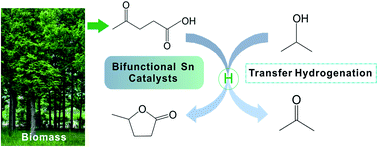Catalytic transfer hydrogenation of levulinic acid to γ-valerolactone over a bifunctional tin catalyst†
Abstract
The conversion of biomass-derived levulinic acid (LA) to γ-valerolactone (GVL) is important but extremely challenging due to the use of noble metal catalysts and high-pressure gaseous hydrogen. Here we describe the transfer hydrogenation of LA to GVL using 2-propanol as hydrogen donor over a Sn modified silica catalyst (SnO2/SBA-15) which gives high LA conversion (85.1%) and GVL selectivity (95.2%). Key to this success is employing a simply synthesized Sn-modified silica catalyst (SnO2/SBA-15) with both Lewis and Brønsted acidity, which could synergistically catalyze the tandem steps of hydrogen transfer and esterification, leading to successful transformation of LA to GVL.


 Please wait while we load your content...
Please wait while we load your content...